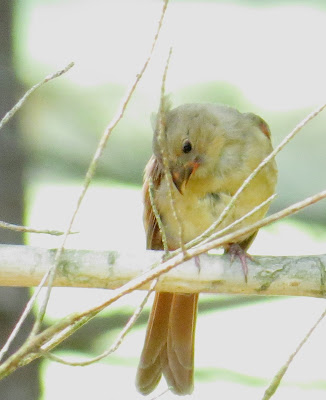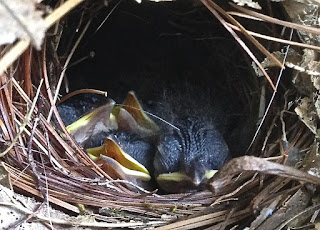 |
| Northern Cardinal - immature |
The feeders and trees are filled with baby birds right now! We were just out walking Blake and saw an adult Eastern Wood-Pewee feeding two juveniles. The adult would sally off into the trees, swoop around until catching a bug, then bring the bug back and feed one of the young-uns. The adult then flew off to catch another bug and feed the other baby. Repeat. Repeat. Repeat...
How can you tell if it is an adult bird or a juvenile bird? That isn't always easy. Sometimes you can tell it is a young bird because they just seem terribly uncoordinated -- not quite landing smoothly, almost falling off the branch, etc. For some birds, like American Robins, it is pretty simple because although the juveniles have the same build as the adults, they sport spotted breasts with only a little of the red on the edges.
The immature Northern Cardinal below is obvious, too! It looks a lot like the adult female, until you look a the beak! Look at the female bird's beak (below, on the left) - bright orange! Look at the juvenile's on the right, more black with a touch of red beginning to appear near the corner of the mouth.
The adult female also has a black patch under the beak and her crest (which is folded down in this picture) is red. (You can look at a larger copy of the photo by clicking on it.)
 |
| Northern Cardinal - immature |
 |
| Northern Cardinal - female |
For other birds, like the Wood-Pewees we saw, the juveniles are very similar to the adults. So how did we know they weren't adults? Because they were just sitting on the branch waiting to be fed!
The inside of the mouth of a baby bird is often bright red, to make it obvious in a dark nest (don't want dad to miss the mouth!). And in nestlings, the beak opens VERY wide with what is called a "gape" at the corners of the mouth so that the mouth opens wider to make it more appealing to the adult ("Here, mom! Put that bug right here!!"). See the picture below of our Carolina Wrens who nested in the carport last year. The two center birds have their mouths open to be fed; look at the one on the right and you can see the beak (black) in the center of the yellow gape.
 | ||
| Carolina Wren Nestlings, first week. Notice LARGE mouth |
 |
| Carolina Wren nestlings, 3 hours before fledging. Notice yellow gape still visible. |
Sometimes you can recognize a juvenile by the wing fluttering. When a baby bird wants to be fed, he/she makes a shivering or fluttering motion with the wings which entices the adult to feed it. This young blue jay below is fluttering its wings and opening its mouth to be fed. Notice that the inside of the mouth is still very red. As the bird matures, the red fades. The adult (lower left) is ignoring the requests for food. "Nope. You've gotta learn to find your own. There is a feeder with seed right behind you!"
 |
| Young Blue Jay fluttering wings & opening mouth to be fed. Adult (lower left) ignoring request. |
We have a family of Rose-breasted Grosbeaks who have just arrived at the feeder and are really chowing down! The adult male is obvious:
 |
| Male Rose-breasted Grosbeak |
The only thing about the female that looks like the male is the beak and the chunky size of the bird! Below is an adult female on the left and I believe the bird on the right is a juvenile, possibly a male. My first clue was in the behavior of the bird on the right; it kept looking like it wanted to be fed, although it never fluttered.
 |
| Rose-breasted Grosbeak, adult female on left, possible juvenile on right. |
 |
| Juvenile Rose-breasted Grosbeak |
An aside on the female Rose-breasted Grosbeak: Usually when a smaller bird is in the feeder tray and a Blue jay shows up, the smaller bird gives way, even if it is an immature Blue Jay. We watched mama grosbeak, who was sitting in the tray chowing down, completely ignore the jay. The jay tried to move in and mama grosbeak went at the jay and chased it off! The jay came back and again was chased off! Go mama!
When I first started taking pictures of the bluebird below, I thought it was an adult female, but then it started fluttering its wings, so I suspected a juvenile. I am leaning toward the juvenile because you can still see a bit of the yellow gape. (see the closeup two pictures down).
 |
| Eastern Bluebird - Juvenile |
 |
| Bluebird - still showing some gape |
Two more pictures of young-uns and I stop this lengthy entry!
Below is a juvenile White-breasted Nuthatch. Notice the darker face - both the male and female adults have pure white faces.
 |
| White-breasted Nuthatch - juvenile |
And lastly, an adult Common Grackle (below) feeding an juvenile. Notice the brown color of the immature and the red inside its mouth.
 |
| "More! More!" "No, this is my seed" |
 |
| Common Grackle adult feeding a juvenile bird |
No comments:
Post a Comment
Please leave a comment about things you have seen and noticed.